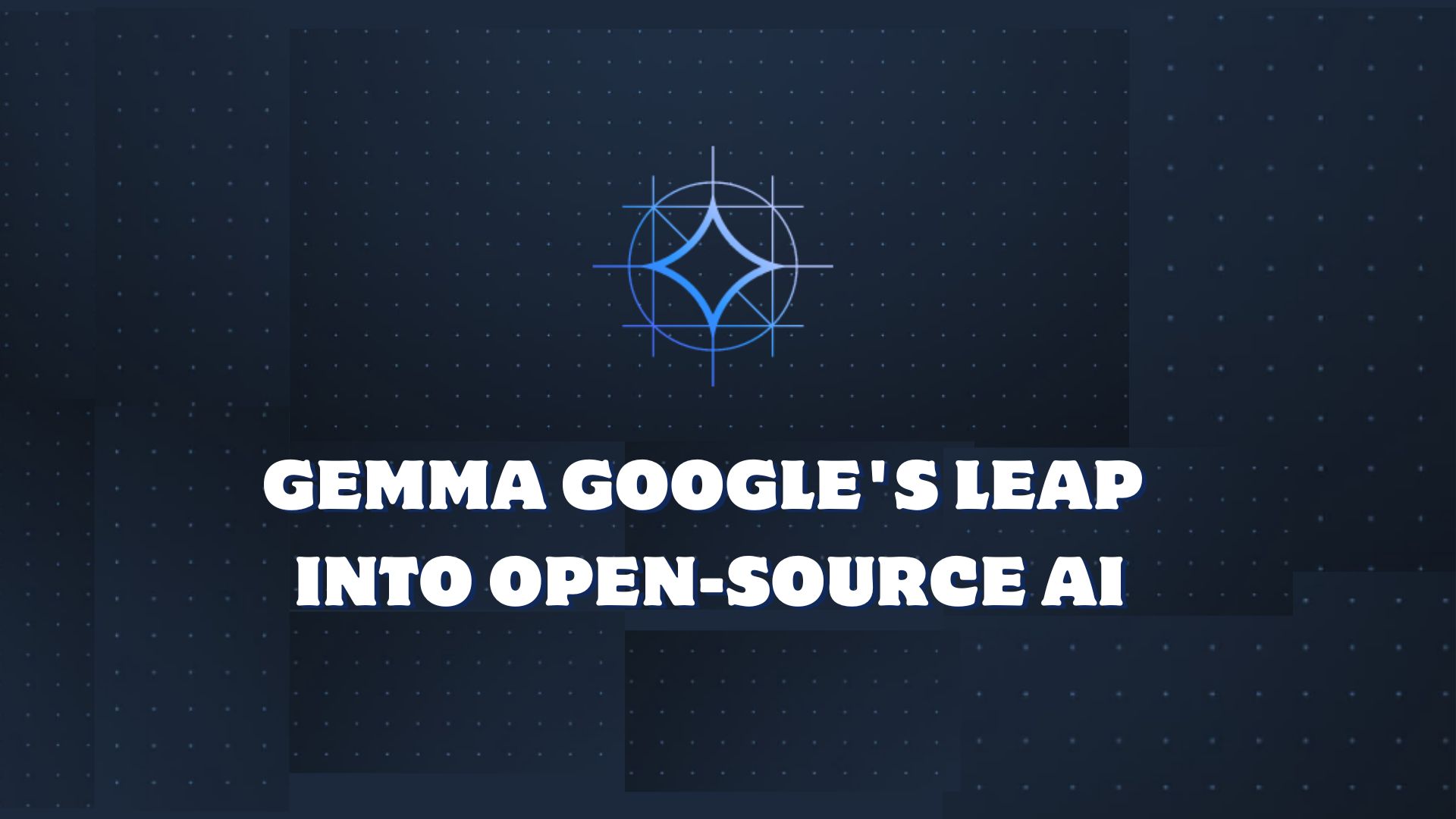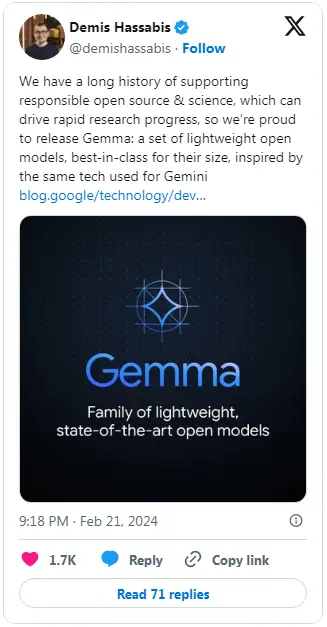Introducing Gemma: Google's Leap into Open-Source AI

In the ever-evolving landscape of artificial intelligence, Google has once again positioned itself at the forefront of innovation with the introduction of Gemma, a groundbreaking leap into the realm of open-source AI. This transformative initiative marks a pivotal moment in the democratization of AI technology, offering developers and researchers around the globe unprecedented access to state-of-the-art tools. As we embark on this exploration of Gemma, we invite you to delve into the intricacies of what makes this model not just a technological advancement, but a beacon for responsible AI development.
Gemma, Google’s latest open-source AI initiative, embodies a new era of accessible, responsible, and collaborative AI development, setting new benchmarks in performance and ethical AI practices.
Table of Contents
What is Gemma?
Gemma emerges as a family of lightweight, yet profoundly capable open models, meticulously crafted from the same foundational research and technology that breathed life into the Gemini models. At its core, Gemma embodies Google’s commitment to fostering an inclusive AI ecosystem, where the barriers to entry are dismantled, and collaborative innovation thrives. Whether you’re a seasoned developer or a curious newcomer to the AI scene, Gemma offers a versatile platform to experiment, innovate, and push the boundaries of what’s possible with AI.

Gemma Key Feature
Scalability and Versatility
Gemma’s architecture is designed with scalability in mind, allowing it to cater to a wide range of applications, from simple chatbots to complex data analysis tasks. Its two versions, Gemma 2B and Gemma 7B, offer flexibility in computational requirements, ensuring that both individual developers and large teams can utilize the model effectively, regardless of their resource availability.
Pre-trained and Instruction-tuned Models
Each Gemma model variant comes pre-trained, saving developers significant time and resources in the initial setup. The instruction-tuned aspect further enhances its usability, enabling the models to understand and execute specific tasks with minimal additional training, making Gemma an ideal choice for rapid deployment in diverse AI projects.
Responsible AI Development
At the heart of Gemma’s design is a commitment to responsible AI. The inclusion of a Responsible Generative AI Toolkit provides developers with the resources to ensure their AI applications are safe, ethical, and aligned with best practices in AI governance. This feature underscores Google’s dedication to fostering an AI ecosystem that prioritizes ethical considerations alongside technological advancements.
Framework Flexibility
Gemma’s compatibility with leading AI development frameworks like JAX, PyTorch, and TensorFlow, facilitated through native Keras 3.0 integration, offers developers the freedom to work within their preferred environments. This flexibility ensures that incorporating Gemma into existing projects or workflows is a seamless process, encouraging widespread adoption and innovation.
Gemma vs. Gemini
Feature | Gemma | Gemini |
Model Type | Open-source, lightweight | Proprietary, heavyweight |
Primary Use | Broad accessibility for developers and researchers | Advanced AI research and large-scale applications |
Model Sizes | 2B and 7B parameters | Up to tens of billions of parameters |
Accessibility | Fully open-source, available for modification and redistribution | Accessible through Google’s API and cloud services |
Intended Audience | Individual developers, small teams, educational purposes | Large enterprises, research institutions |
Support for Responsible AI | Includes a Responsible Generative AI Toolkit | Adheres to Google’s AI Principles, but toolkit not explicitly provided |
Framework Compatibility | Wide compatibility with JAX, PyTorch, TensorFlow via Keras 3.0 | Limited to Google’s infrastructure and tools |
Pre-training and Tuning | Pre-trained and instruction-tuned for immediate use | Extensively pre-trained, requires more resources for fine-tuning |
How to Get Started with Gemma?
- Explore the Documentation: Begin by visiting the official Gemma documentation page on Google AI. Familiarize yourself with the model’s capabilities, architecture, and the Responsible AI Toolkit.
- Choose Your Model Variant: Decide between Gemma 2B and Gemma 7B based on your project’s needs and the computational resources at your disposal.
- Set Up Your Development Environment: Ensure your development environment is ready, with support for JAX, PyTorch, or TensorFlow, and Keras 3.0 installed.
- Download the Model Weights: Access the pre-trained Gemma model weights from Google’s model repository or through platforms like Kaggle and Hugging Face.
- Integrate Gemma into Your Project: Utilize the model within your existing projects, leveraging the extensive documentation and community examples to guide your implementation.
- Leverage the Responsible AI Toolkit: Apply the tools and guidelines provided in the Responsible Generative AI Toolkit to ensure your application aligns with ethical AI practices.
- Join the Community: Engage with the Gemma community through forums, GitHub, or Google’s AI blog to stay updated on the latest developments, share your experiences, and get support.
Gemma's Performance Benchmarks
Gemma sets a new standard in the AI landscape with its impressive performance benchmarks, showcasing its ability to handle a wide array of tasks with remarkable efficiency and accuracy. The Gemma 2B and 7B models, despite their relatively compact size, demonstrate capabilities that rival and, in some instances, surpass larger and more resource-intensive models. This is particularly evident in natural language processing tasks, where Gemma’s nuanced understanding of language nuances shines.
In benchmark tests, Gemma has shown exceptional performance in areas such as language comprehension, sentence completion, and even complex problem-solving scenarios. Its ability to maintain high accuracy while minimizing computational load makes it an ideal choice for developers looking to deploy AI solutions in environments with limited resources. Furthermore, Gemma’s performance in multi-task learning and adaptability to diverse datasets underscores its versatility, making it a robust tool for a broad spectrum of AI applications.
Responsible AI with Gemma
Google’s commitment to responsible AI development is deeply ingrained in Gemma’s design and functionality. The model is not only built on the foundation of ethical AI practices but also equipped with comprehensive tools and guidelines to assist developers in creating AI solutions that are safe, transparent, and aligned with societal values.
The Responsible Generative AI Toolkit that accompanies Gemma is a testament to this commitment. It provides developers with a suite of resources, including safety classifiers, debugging tools, and best practice guidelines, to ensure the ethical deployment of AI technologies. This toolkit empowers developers to proactively address potential biases, ensure data privacy, and maintain the integrity of their AI applications.
Moreover, Gemma’s training process incorporates extensive measures to filter out sensitive and personal information, ensuring that the model generates outputs that respect user privacy and ethical standards. The model’s instruction-tuned variants are specifically designed to align with responsible behaviors, further minimizing the risk of generating harmful or biased content.
Through these initiatives, Gemma not only advances the technical capabilities of AI models but also sets a precedent for the development of AI technologies that contribute positively to society and adhere to the highest ethical standards.
Gemma's Integration with Popular Tools
Gemma’s design is rooted in two core principles: innovation and seamless integration, making it a versatile tool in the AI development landscape:
- Broad Framework Compatibility: Gemma is designed to work effortlessly with a range of popular development environments. This includes:
- JAX: For high-performance machine learning research.
- PyTorch: Known for its flexibility and ease of use in research and development.
- TensorFlow via Keras 3.0: Offers extensive support for deep learning applications, ensuring Gemma’s integration is smooth and efficient.
- Open-Source Collaboration: Gemma thrives in a collaborative ecosystem, encouraging developers to engage in a shared development process. Key platforms for this collaboration include:
- Hugging Face: A hub for sharing and discovering pre-trained models, fostering community-driven AI advancements.
- NVIDIA NeMo: Optimizes Gemma for high-performance computing, particularly on NVIDIA’s hardware, enhancing its utility in demanding AI tasks.
Gemma’s adaptability makes it suitable for a diverse array of applications, from generating text to tackling intricate, context-sensitive challenges. This flexibility, combined with its open-source nature, positions Gemma as a valuable asset for developers looking to push the boundaries of AI without being constrained by their existing technological frameworks.
Future of Open-Source AI with Gemma
The release of Gemma by Google marks a significant milestone in the journey towards a more open, accessible, and collaborative AI future. As an open-source model, Gemma not only democratizes access to state-of-the-art AI technologies but also invites a global community of developers, researchers, and enthusiasts to contribute to its evolution. This collaborative approach is poised to accelerate innovation in AI, breaking down barriers and fostering a culture of shared knowledge and resources.
Looking ahead, the future of open-source AI with Gemma promises a landscape where AI technologies are more transparent, ethical, and inclusive. The model’s emphasis on responsible AI development and its integration with popular tools lay the groundwork for a new era of AI applications that are not only technologically advanced but also aligned with societal values and ethical standards.
Moreover, as the AI community continues to grow and diversify, Gemma’s open-source nature will enable a broader range of voices and perspectives to shape the direction of AI development. This inclusivity is crucial for ensuring that AI technologies serve the needs of a wide array of users and address a diverse set of challenges.
Conclusion
Gemma is more than just an AI model; it’s a testament to Google’s vision for an open, collaborative, and responsible AI future. As we embrace Gemma, we step into a new era of AI development, marked by unprecedented access to state-of-the-art technology and a shared commitment to shaping a better world through responsible AI innovation.

